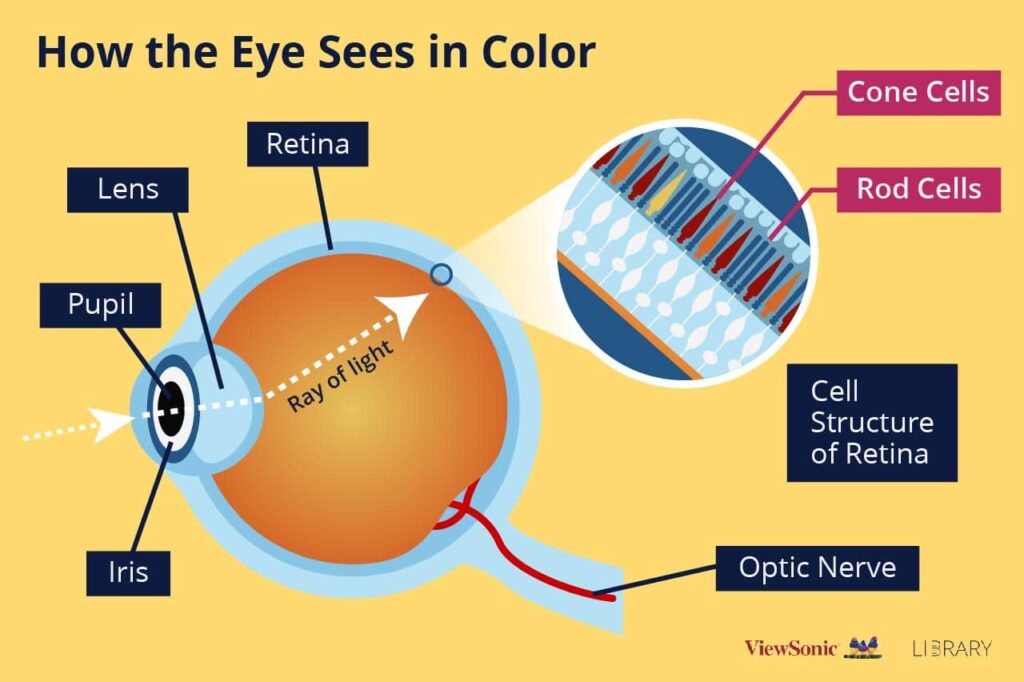also known as color vision deficiency, is a fascinating yet often misunderstood visual impairment.
Contrary to popular belief, it doesn’t mean seeing the world in black and white but rather experiencing a limited range of colors or difficulty distinguishing specific hues.
In this article, we will delve into the world of color blindness, exploring its causes, types, and the challenges faced by those living with this condition.
What Is Color Blindness?

Color blindness is a visual deficiency that affects an individual’s ability to perceive certain colors accurately.
It occurs when the photoreceptor cells in the retina of the eye, called cones, do not function correctly.
Cones are responsible for detecting different wavelengths of light, which are then processed by the brain as colors.
Types of Color Blindness

There are several types of each characterized by specific color perception issues:
Red-Green Color Blindness:
This is the most common form of , where individuals have difficulty distinguishing between red and green hues.
It can be further divided into two subtypes: protanopia (reduced sensitivity to red light) and deuteranopia (reduced sensitivity to green light).
Blue-Yellow Color Blindness:
Less common than red-green color blindness, this type affects the perception of blue and yellow colors.
Tritanopia is a rare subtype where individuals struggle with distinguishing blue and yellow.
Total Color Blindness (Monochromacy):
In extremely rare cases, individuals may see the world in shades of gray, with no ability to perceive color. This is known as monochromacy.
Achromatopsia:
This is a severe form of color blindness characterized by the inability to see any colors at all. Individuals with achromatopsia often have extreme light sensitivity and low vision.
Causes of Color Blindness
Color blindness can be inherited genetically, and it’s more common in men than women. The condition is typically passed down through the X chromosome.
If a man inherits the faulty gene from his mother, he will experience color blindness. However, https://lovishweb.com/
it’s less common for women to be affected because they have two X chromosomes, and a mutation in one can be compensated by the other.
In addition to genetic factors, color blindness can also result from certain medical conditions, injuries to the eye, or exposure to chemicals.
Regular eye exams can help diagnose color blindness and identify its specific type.
Living with Color Blindness

Living with color blindness can present unique challenges in various aspects of life. Here are some of the common difficulties individuals with color blindness may encounter:
Education:
Color-coded information in textbooks and classroom materials can be confusing for color-blind students.
Teachers and educational institutions can make accommodations to ensure an inclusive learning environment.
Occupation:
Some professions, such as graphic design and electrical work, may pose challenges for color-blind individuals.
However, with proper training and accommodations, many people with color blindness excel in their chosen careers.
Daily Life:
Everyday tasks like choosing clothes, identifying ripe fruits, or reading traffic lights can be tricky.
Color-blind individuals often develop coping strategies, such as memorizing the order of traffic lights or relying on color-identifying apps.
Safety:
Color-coded safety warnings or signs can be missed or misinterpreted, potentially leading to safety hazards.
Employers and authorities should take measures to ensure safety for color-blind individuals.
Support and Resources
Fortunately, there are various resources and tools available to support individuals with color blindness:
Color-Correcting Glasses:
EnChroma glasses are designed to enhance color perception for some individuals with red-green color blindness.
Color-Identifying Apps:
Mobile apps like Color Blind Pal can help identify and differentiate colors using a smartphone’s camera.
Accessibility Features:
Many digital devices and apps offer accessibility features like color adjustments and screen readers to assist color-blind users.
For Individuals with Color Blindness:
Regular Eye Exams:
Schedule regular eye examinations with an eye specialist to monitor your condition and ensure early detection of any eye-related issues.
Color Identification Apps:
Use color identification apps on your smartphone to help distinguish colors in daily life. These apps can provide instant feedback on colors using the device’s camera.
Labeling Clothing:
Consider labeling your clothing or organizing your wardrobe in a way that makes it easier to select matching outfits. You can use tactile labels or a system of folding clothes in specific patterns.
Learn Color Patterns:
Familiarize yourself with color patterns rather than relying solely on color cues. For example, traffic light order (red, yellow, green) or the order of the rainbow (red, orange, yellow, green, blue, indigo, violet).
Seek Accommodations:
If you’re in a profession where color distinctions are crucial, discuss accommodations with your employer.
This might include using alternative color codes, markings, or relying on colleagues for color-related tasks.
For People Interacting with Individuals with Color Blindness:
Be Understanding:
Understand that color blindness is not a choice, and individuals with this condition may sometimes struggle with color-related tasks.
Be patient and avoid making jokes or comments that may be insensitive.
Use Clear Communication:
When conveying information, especially if it involves colors, be as descriptive as possible. Instead of saying, “Please pass me the red pen,” you can say, “Please pass me the pen on the right side.”
Accessibility in Design:
If you work in design or create content for a wide audience, consider using accessible color palettes that are easily distinguishable by individuals with color blindness.
Various online tools can help you test color combinations for accessibility.
Avoid Red-Green Combinations:
Be cautious with color combinations like red and green, which can be problematic for people with red-green color blindness. Use alternative combinations or patterns when applicable.
In Educational Settings:
Teachers can provide color-blind students with materials that are inclusive and not solely reliant on color coding. This can include using patterns or labels in addition to colors.
Safety Precautions:
.In situations where safety is a concern, ensure that warning signs, labels, or safety instructions are clear and easily understandable by individuals with color blindness.
Additional symbols or text descriptions can help convey important information.
By taking these precautions and fostering awareness, we can create a more inclusive environment for individuals with color blindness and ensure they can navigate their daily lives with greater ease and confidence.
For Individuals with Color Blindness:
Use High-Contrast Settings:
Adjust the settings on digital devices such as smartphones and computers to increase contrast. This can make text and graphics more legible.
Identify Color Codes:
If color-coded information is essential in your profession or hobbies, consider using a reference guide or cheat sheet to help you interpret colors accurately.
Advocate for Accommodations:
Don’t hesitate to communicate your color blindness with employers or educators and request reasonable accommodations. This can include using color-blind-friendly software or alternative labeling systems.
Outdoor Activities:
When participating in outdoor activities like hiking or camping, be cautious about potential hazards marked with color-coded signs. Always ask for clarification if unsure about a sign’s meaning.
Color-Blind Tools:
Explore assistive tools designed specifically for color-blind individuals. There are specialized apps, computer programs, and even specialized glasses, like EnChroma, that can enhance color perception.
For People Interacting with Individuals with Color Blindness:
Avoid Critical Color-Coding:
If you’re in a position where you must convey critical information through color codes, try to use additional cues like shapes, numbers, or labels alongside colors. This redundancy can prevent misunderstandings.
Be Mindful in Art and Design:
When creating art, designs, or presentations, remember that certain color combinations may be challenging for color-blind viewers. Utilize tools that simulate various types of color blindness to test your work for accessibility.
Assist in Color Matching:
When shopping for clothes or selecting items with color options, offer to help individuals with color blindness choose appropriate colors. Sharing fashion advice or offering color suggestions can be supportive.
Enhance Accessibility at Home:
If you have a family member or roommate with color blindness, consider making home adjustments like labeling light switches or differentiating household items with textures or shapes.
Educate Others:
Promote awareness and educate those around you about color blindness. The more people understand the challenges faced by individuals with color blindness, the more inclusive and accommodating society can become.
Emergency Preparedness:
In emergency situations, be sure to communicate critical information clearly and concisely without relying solely on color-coded signals. Having a plan that accounts for color blindness can be a lifesaver.
For Individuals with Color Blindness:
Use Color Filters:
Some digital devices, like smartphones, offer color filters that can help enhance color perception. Experiment with these settings to find what works best for you.
Career Planning:
When choosing a career path, consider professions that are less reliant on color perception. Fields like mathematics, computer science, or writing may be more suitable, depending on your interests and strengths.
Public Transport:
Pay close attention to public transportation systems where color-coded information is common, such as subway or bus maps. Memorize routes, station names, and directions to navigate efficiently.
Driving Safety:
When driving, focus on using position, shape, and intensity of traffic lights rather than relying solely on color. It’s crucial to recognize the top-to-bottom sequence of lights (red, yellow, green) for safe driving.
Advocate for Accessibility:
Encourage businesses and organizations to adopt color-blind-friendly practices. This can include accessible website design, color-coded information with additional cues, and using color-blind-friendly signage.
For People Interacting with Individuals with Color Blindness:
Interactive Media:
In video games, web design, and other interactive media, provide options for color-blind modes or settings that adjust the visuals for better accessibility.
Educational Support:
Teachers and educators should be aware of color blindness among students. Offer alternative methods of teaching, provide study materials with clear labeling, and ensure that exams are designed with color-blind students in mind.
Social Gatherings:
When organizing social events, consider the preferences of color-blind friends or family members. Choose games or activities that do not heavily rely on color distinctions.
Accessible Artwork:
.In museums or art galleries, provide clear descriptions or labels for artwork to help color-blind visitors appreciate and understand the pieces fully.
Public Awareness Campaigns:
Support and participate in campaigns that raise awareness about color blindness and promote inclusivity. Share educational materials and resources with your community.
Online Content:
Content creators, especially those on social media, can use accessibility features like image descriptions to make visual content more inclusive. Describe the colors and content of images to ensure everyone can engage with the content.
conclusion
Remember that the key to accommodating individuals with color blindness is empathy, open communication, and a willingness to make small adjustments in various aspects of life to ensure inclusivity and accessibility.
By taking these precautions and being considerate of the challenges faced by individuals with color blindness, we can create a more inclusive and supportive world for everyone.
Color blindness is a unique visual impairment that affects how individuals perceive and interact with the world around them.
While there is no cure, understanding the causes and types of color blindness can help create a more inclusive society.
By raising awareness and providing support, we can empower individuals with color blindness to overcome challenges and lead fulfilling lives, embracing the vibrant world of color in their own way.
